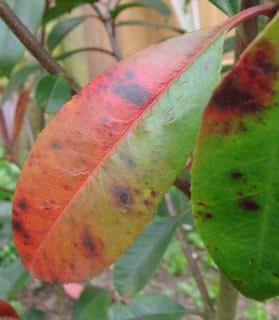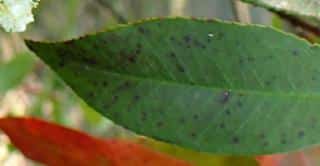Photinia shrubs sometimes catch a fungus called Photinia leaf spot or black spot.
Leaves are dotted with black spots that slowly spread until leaves wilt and fall off.
Little spots similar to tar spots appear on leaves.
This disease is rarely deadly, although it does lessen the beauty of your Photinia. Learn how to treat the disease and what causes it.
Note: some varieties of photinia naturally have spots: the ‘Pink Crispy’ has darker green spots all over, and the ‘Pink Marble’ has white variegation.
Treating Photinia leaf spot disease
Protecting photinia from leaf spot
 Anti-fungal spray such as Bordeaux mixture is one of the best ways to prevent Photinia from falling sick.
Anti-fungal spray such as Bordeaux mixture is one of the best ways to prevent Photinia from falling sick.- It’s also possible to prepare your own natural fungicide from weeds and plants that might grow in your garden.
- Spray at the end of winter or at the very beginning of spring.
- Don’t spray if temperatures are below freezing.
- Rake up or collect any leaves that are infected instead of leaving them near the shrub. Destroy them either by burning them or thorough composting.
Since the fungus spreads through splashing water from shrub to shrub, you can prevent photinia leaf spot if you :
- Plant different varieties near each other in a mixed hedge, instead of only planting Photinia.
- Alternate Photinia with other evergreen hedge shrubs
- Prune your photinia as a standalone into a tree shape, to avoid low-lying leaves.
- Water only near the ground, without splashing the leaves.
- Avoid pruning in summer, because this would trigger new growth that the fungus will quickly colonize.
How to treat photinia leaf spot
Once leaf spot disease has appeared:
- You should pick all infected leaves by pruning them out.
- Diligently disinfect your pruning shears, scissors or secateur with methylated spirits or alcohol between cuts.
- Spray at two week intervals, preferably just after a rain or shower.
- Spray again with Bordeaux mix in fall.
What causes Photinia leaf spot?
 A fungus called Entomosporium maculatum is what causes leaf spot on photinia.
A fungus called Entomosporium maculatum is what causes leaf spot on photinia.
It is a microscopic fungus that overwinters on twigs and leaves that have fallen on the ground. It is quite common and prefers to infect weak and stressed trees.
Symptoms of Photinia Entomosporium leaf spot
- It starts off by creating spots of light swelling on leaves and then the color changes to brown and dark red, and ultimately to black or gray.
- Young leaves and growth are the most affected.
- In severe cases, spots grow until the entire leaf is weakened and falls off. Sometimes this happens before the leaf is even fully mature (still red).
- First signs of infection appear near the ground on the lower levels of the tree.
- Usually only leaves are affected, but sometimes buds and green shoots show signs of infection, too.
- If untreated and conditions are suitable to the fungus, the photinia may die.
What conditions trigger photinia leaf spot?
- Moisture, as for all fungus, is the main driver for photinia leaf spot.
- Cool temperatures speed the spread of the disease (but it’s dormant when freezing).
- Growing photinia close together also makes the fungus spread quickly.
- Water splashing spreads the fungus spores (like seeds) from leaf to leaf.
- Branches and leafage that hover near the ground are particularly prone to leaf spot, such as in hedges.
From all the photinia species, one of the most vulnerable varieties is the “Red tip” Photinia x Fraseri.
Entomosporium leaf spot is usually harmless in most climates, especially where summers are hot and dry. However, in moist climates with very wet spring and fall seasons, it may prove fatal to your photinia hedge.
Photinia leaf spot spread and contamination
Photinia is a wonderful hedge shrub and it’s often grown as a hedge. When leaf spot appears, it’s time to check for alternatives that may also bring joy without the hassle of dealing with the disease.
- Good to know: growing a mixed hedge reduces spread of black spot disease.
Can Photinia leaf spot spread to other trees and shrubs?
This particular strand of leaf spot, Entomosporium, can directly infect other members of the Rosaceae family such as:
What shrubs similar to Photinia resist leaf spot?
A favorite shrub that resists leaf spot is holly, as does its North-American endemic counterpart yaupon.
Beautiful flowering alternatives include Escallonia, Mock-orange, Weigela, Camellia and a host of other flowering-bearing hedge shrubs.
With unremarkable flowers but beautiful silvery leaves, silverberry also fills the spot… without leaf spots!
Spotted laurel is also beautiful, with built-in yellow spots on its evergreen leaves that don’t endanger the plant as a fungus would.
Smart tip about Photinia leaf spot
If you’re preparing cuttings from your favorite photinia, try to collect cuttings from specimens that aren’t infected to make sure the disease isn’t propagated, too.


 Anti-fungal spray such as Bordeaux mixture is one of the best ways to prevent Photinia from falling sick.
Anti-fungal spray such as Bordeaux mixture is one of the best ways to prevent Photinia from falling sick. A fungus called Entomosporium maculatum is what causes leaf spot on photinia.
A fungus called Entomosporium maculatum is what causes leaf spot on photinia.
Photinia leaf spot, when I was looking at this problem in my garden I was really dishearten for this reasons. I like this plant and it adds beauty to the garden. Thanks for valuable information.